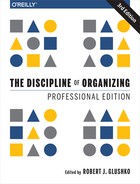Chapter 4. Resource Description and Metadata
4.1. Introduction
Click. A professional photographer standing on a mountainside takes a picture with a digital camera. What information should be recorded and associated with the recorded image of the mountain scene? Modern cameras assign an identifier to the stored photograph and they also capture the technical description of the image’s production: the type of camera, lens, shutter speed, light sensitivity, aperture, and other settings.190[Com] Many modern cameras also record information about the geographic and temporal circumstances surrounding the image’s creation: the date, time and location on Earth where the photograph is taken. When the image is transferred out of the camera and is published for all to see, it might be useful to record biographical information about the photographer to help viewers relate to the photographer and better understand the photograph’s context. There may also be different licenses and copyright information to associate with the picture—who owns it and how it can be used.
[190][Com] Most digital cameras use the
Exchangeable Image File
Format (EXIF). The
best source of information about it looks like its
Wikipedia entry.
http://en.wikipedia.org/wiki/Exchangeable_image_file_format.
Four 7-year old boys are selecting Lego blocks to complete their latest construction. The first boy is looking for “cylinder one-ers,” another for “coke bottles,” the third for “golder wipers,” and the final boy is looking for “round one-bricks”? It turns out, they are all the same thing; each boy has devised his own set of descriptive terms for the tiny building blocks. Some of their many descriptions are based on color alone (“redder”), some on color and shape (“blue tunnel”), some on role (“connector”), some on common cultural touchstones (“light saber”). Others, like “jail snail” and “slug,” seem unidentifiable—unless, of course, you happen to be inside the mind of a particular 7-year-old kid. That does not matter, so long as their descriptions allow the boys to understand each other.191[Cog]
[191][Cog] This is much more than just a “kids say the darndest things”
story (see
http://en.wikipedia.org/wiki/Kids_Say_the_Darndest_Things
). Giles Turnbull
(Turnbull
2009) noticed that his kids never used the official names for
Lego blocks (e.g., Brick 2x2). He then asked other kids what their names were
for 32 types of Lego blocks. His survey showed that the kids mostly used
different names, but each created names that followed some systematic
principles. The most standard name was the “light saber,” used by
every kid in Turnbull’s sample.
Digital photos and Lego blocks are very different, yet for our purposes these scenarios are both about resource description. Together both scenarios raise important questions about describing resources that we answer in this chapter: What is the purpose of resource description? What resource properties should be described? How are resource descriptions created? What makes a good resource description?
